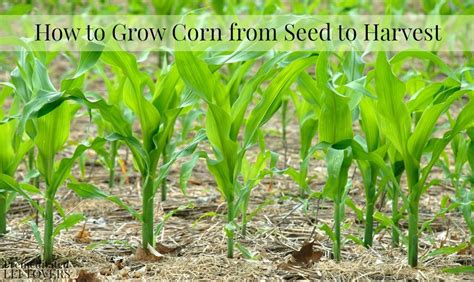How To Grow Corn: A Guide to a Bountiful Harvest
Growing your own corn can be a rewarding experience, providing you with sweet, delicious ears all summer long. This comprehensive guide will walk you through the process, from seed selection to harvest, ensuring a successful and bountiful crop. Whether you're a seasoned gardener or a complete beginner, this guide will equip you with the knowledge you need.
Choosing the Right Corn Variety
The first step to a successful corn harvest is selecting the right variety. Consider these factors:
- Growing Season: Choose a variety that matures within your area's frost-free growing season. Check seed packets for days to maturity.
- Type of Corn: Sweet corn is the most popular choice for home gardeners, but you can also grow popcorn, flint corn (for cornmeal), or even ornamental corn.
- Height: Some corn varieties grow much taller than others. Consider the space you have available.
Pro Tip: Start your seeds indoors 4-6 weeks before the last expected frost to give them a head start.
Preparing Your Garden Bed
Proper soil preparation is crucial for healthy corn growth. Follow these steps:
- Sunlight: Corn needs at least six hours of direct sunlight per day.
- Soil: Corn thrives in well-drained, fertile soil with a slightly acidic to neutral pH (6.0-7.0). Amend heavy clay soil with compost or other organic matter to improve drainage.
- Spacing: Plant corn seeds in blocks or rows, spacing them 12-18 inches apart within the rows and 2-3 feet apart between rows for adequate space. This allows for good air circulation and prevents overcrowding.
Planting Your Corn Seeds
- Planting Depth: Plant seeds 1-2 inches deep.
- Watering: Water thoroughly after planting.
- Fertilizing: Corn is a heavy feeder, so consider adding a balanced fertilizer according to package instructions. This will ensure robust growth and strong stalks.
Caring for Your Corn Plants
Ongoing care is essential for a successful harvest. Here's what you need to do:
Watering:
- Consistent watering is key, especially during dry spells. Aim for 1 inch of water per week. Mulching around the plants helps retain moisture.
Weeding:
- Keep the area around your corn plants free of weeds to prevent competition for nutrients and water.
Pest and Disease Control:
- Monitor your plants regularly for signs of pests or diseases. Address any issues promptly using appropriate methods. Consider companion planting – using plants that deter pests near your corn.
Pollination:
- Corn relies on wind pollination. Planting corn in blocks rather than single rows maximizes pollination efficiency.
Harvesting Your Corn
Sweet corn is ready for harvest when the silks at the top of the ear are brown and dry, and the kernels are plump and milky. To test for ripeness, gently press a kernel – it should release a milky liquid. Harvest by carefully breaking the ears off the stalk.
Troubleshooting Common Corn Growing Problems
- Stunted Growth: Check for nutrient deficiencies or pest infestations.
- Poor Ear Development: Insufficient pollination or improper spacing may be the cause.
- Fungal Diseases: Ensure good air circulation and avoid overhead watering.
By following these steps, you'll be well on your way to growing a delicious and abundant corn harvest. Remember to adjust your techniques based on your specific climate and soil conditions. Happy gardening!
